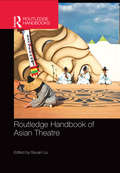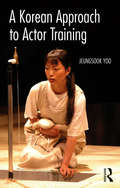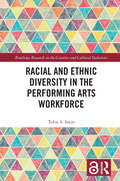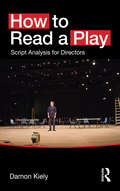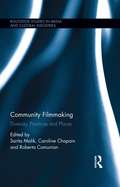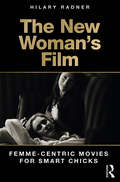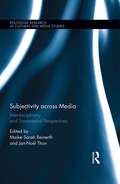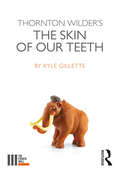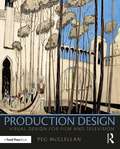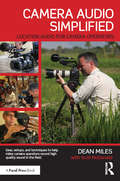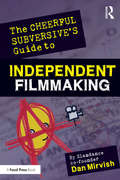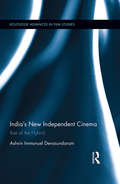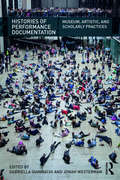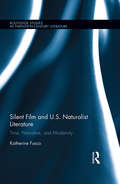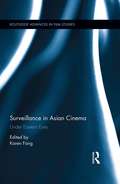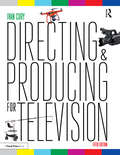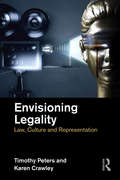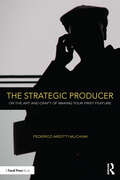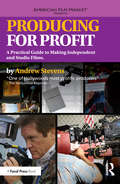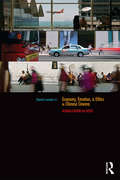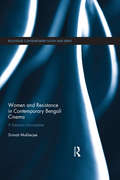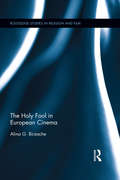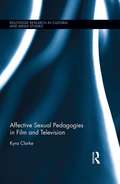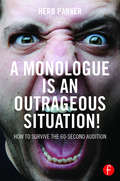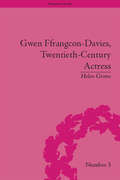- Table View
- List View
Routledge Handbook of Asian Theatre
by Siyuan LiuRoutledge Handbook of Asian Theatre is an advanced level reference guide which surveys the rich and diverse traditions of classical and contemporary performing arts in Asia, showcasing significant scholarship in recent years. An international team of over 50 contributors provide authoritative overviews on a variety of topics across Asia, including dance, music, puppetry, make-up and costume, architecture, colonialism, modernity, gender, musicals, and intercultural Shakespeare. This volume is divided into four sections covering: Representative Theatrical Traditions in Asia. Cross-Regional Aspects of Classical and Folk Theatres. Modern and Contemporary Theatres in Asian Countries. Modernity, Gender Performance, Intercultural and Musical Theatre in Asia. Offering a cutting edge overview of Asian theatre and performance, the Handbook is an invaluable resource for academics, researchers and students studying this ever-evolving field.
A Korean Approach to Actor Training
by Jeungsook YooA Korean Approach to Actor Training develops a vital, intercultural method of performer training, introducing Korean and more broadly East Asian discourses into contemporary training and acting practice. This volume examines the psychophysical nature of a performer’s creative process, applying Dahnhak, a form of Korean meditation, and its central principle of ki-energy, to the processes and dramaturgies of acting. A practitioner as well as a scholar, Jeungsook Yoo draws upon her own experiences of training and performing, addressing productions including Bald Soprano (2004), Water Station (2004) and Playing ‘The Maids’ (2013–2015). A significant contribution to contemporary acting theory, A Korean Approach to Actor Training provides a fresh outlook on performer training which will be invaluable to scholars and practitioners alike.
Racial and Ethnic Diversity in the Performing Arts Workforce (Routledge Research in the Creative and Cultural Industries)
by Tobie S. SteinRacial and Ethnic Diversity in the Performing Arts Workforce examines the systemic and institutional barriers and individual biases that continue to perpetuate a predominately White nonprofit performing arts workforce in the United States. Workforce diversity, for purposes of this book, is defined as racial and ethnic diversity among workforce participants and stakeholders in the performing arts, including employees, artists, board members, funders, donors, educators, audience, and community members. The research explicitly uncovers the sociological and psychological reasons for inequitable workforce policies and practices within the historically White nonprofit performing arts sector, and provides examples of the ways in which transformative leaders, sharing a multiplicity of cultural backgrounds, can collaboratively and collectively create and produce a culturally plural community-centered workforce in the performing arts. Chapter 1 of this book is freely available as a downloadable Open Access PDF at http://www.taylorfrancis.com under a Creative Commons Attribution-Non Commercial-No Derivatives (CC-BY-NC-ND) 4.0 license.
How to Read a Play: Script Analysis for Directors
by Damon KielyThe work done on a play before the first rehearsal, the first group reading or even the before the cast have met, can be crucial to the success of a production. Directors and dramaturgs must know how to analyze, understand and interpret a play or performance text if they hope to bring it to life on the stage. This book provides a broad range of tools and methods that can be used when reading a text, including: Lessons from the past. What can we learn from Aristotle, Stanislavsky, Meyerhold, Vakhtangov, Brecht and Harold Clurman? This section establishes the models and methods that underpin much of a director’s work today. A survey of current practices in Western theatre. A combination of research, interviews and observation of practical work addresses the main stages in understanding a play, such as getting to know characters, sharing ideas, mapping the action and grappling with language. A workbook, setting out twenty one ways of breaking down a play, from the general to the particular. Contributions, reflections and interjections from a host of successful directors make this the ideal starting point for anyone who wants to direct a play, or even devise one of their own. This wide range of different approaches, options and techniques allows each reader to create their own brand of play analysis.
Community Filmmaking: Diversity, Practices and Places (Routledge Studies in Media and Cultural Industries)
by Sarita Malik Caroline Chapain Roberta ComunianThis book examines the role of community filmmaking in society and its connection with issues of cultural diversity, innovation, policy and practice in various places. Deploying a range of examples from Europe, North America, Australia and Hong Kong, the chapters show that film emerging from outside the mainstream film industries and within community contexts can lead to innovation in terms of both content and processes and a better representation of the cultural diversity of a range of communities and places. The book aims to situate the community filmmaker as the central node in the complex network of relationships between diverse communities, funding bodies, policy and the film industries.
The New Woman's Film: Femme-centric Movies for Smart Chicks
by Hilary RadnerWith the chick flick arguably in decline, film scholars may well ask: what has become of the woman’s film? Little attention has been paid to the proliferation of films, often from the independent sector, that do not sit comfortably in either the category of popular culture or that of high art––films that are perhaps the corollary of the middle-brow novel, or "smart-chick flicks". This book seeks to fill this void by focusing on the steady stream of films about and for women that emerge out of independent American and European cinema, and that are designed to address an international female audience. The new woman's film as a genre includes narratives with strong ties to the woman’s film of classical Hollywood while constituting a new distinctive cycle of female-centered films that in many ways continue the project of second-wave feminism, albeit in a modified form. Topics addressed include: The Bridges of Madison County (Clint Eastwood, 1995); the feature-length films of Nicole Holofcener, 1996-2013; the film roles of Tilda Swinton; Rachel Getting Married (Jonathan Demme, 2008); Blue Jasmine (Woody Allen, 2013); Frances Ha (Noah Baumbach, 2012), Belle (Amma Asante, 2013), Fifty Shades of Grey (Sam Taylor-Johnson, 2015) and Jane Campion’s Top of the Lake (Sundance Channel, 2013-).
Subjectivity across Media: Interdisciplinary and Transmedial Perspectives (Routledge Research in Cultural and Media Studies)
by Jan-Noël Thon Maike Sarah ReinerthMedia in general and narrative media in particular have the potential to represent not only a variety of both possible and actual worlds but also the perception and consciousness of characters in these worlds. Hence, media can be understood as "qualia machines," as technologies that allow for the production of subjective experiences within the affordances and limitations posed by the conventions of their specific mediality. This edited collection examines the transmedial as well as the medium-specific strategies employed by the verbal representations characteristic for literary texts, the verbal-pictorial representations characteristic for comics, the audiovisual representations characteristic for films, and the interactive representations characteristic for video games. Combining theoretical perspectives from analytic philosophy, cognitive theory, and narratology with approaches from phenomenology, psychosemiotics, and social semiotics, the contributions collected in this volume provide a state-of-the-art map of current research on a wide variety of ways in which subjectivity can be represented across conventionally distinct media.
Thornton Wilder's The Skin of our Teeth (The Fourth Wall)
by Kyle Gillette"Ladies and gentlemen, I’m not going to play this particular scene tonight." - Sabina Thornton Wilder’s The Skin of Our Teeth (1942) telescopes an audacious stretch of western history and mythology into a family drama, showing how the course of human events operates like theatre itself: constantly mutable, vanishing and beginning again. Kyle Gillette explores Wilder’s extraordinary play in three parts. Part I unpacks the play’s singular yet deeply interconnected place in theatre history, comparing its metatheatrics to those of Stein, Pirandello and Brecht, and finding its anticipation of American fantasias in the works of Vogel and Kushner. Part II turns to the play’s many historic and mythic sources, and examines its concentration of western progress and power into the model of a white, American upper-middle-class nuclear family. Part III takes a longer view, tangling with the play’s philosophical stakes. Gillette magnifies the play’s ideas and connections, teasing out historical, theoretical and philosophical questions on behalf of readers, scholars and audience members alike.
Production Design: Visual Design for Film and Television
by Peg McClellanProduction Design: Visual Design for Film and Television is a hands-on guide to the craft of Production Design and Art Direction. Author Peg McClellan gives an insider’s view of the experiences and challenges of working as a Production Designer in film and television. The book covers three major areas, starting with an overview and the basics of job responsibilities, the artistic approach and the background which every Production Designer needs to be familiar with, and progressing to the mechanics of the role with a day-to-day breakdown of the job itself. McClellan takes you through script analysis, team collaborations, the hierarchy of a production, hiring a team, the business elements, locations, studio facilities, handling change, and everything in between. With case studies, insights from successful Production Designers, and inspiration in the form of over 200 colour photos and illustrations from storyboards to sets, this is the ideal book for students seeking a career in production design, and professionals looking to further their design knowledge.
Camera Audio Simplified: Location Audio for Camera Operators
by Dean MilesYou’ve spent a lot of time learning how to use the features of your video camera to take amazing pictures, but chances are the audio always gives you trouble! Today, with production budgets shrinking, many are being asked to go-it-alone and sound is a frequent pain point that can drag production value down to an amateur level. To achieve great sound to go along with great video, you need to go beyond "automatic" mode and take control – know as much about microphones as you do about lenses with the help of Camera Audio Simplified. Author Dean Miles gives you the skills you need to capture quality location audio with your camera mic, wireless system, lavaliers, and handheld microphones. You’ll get step-by-step guidance to help elevate your sound from amateur to professional – and build your career and video production business.
The Cheerful Subversive's Guide to Independent Filmmaking: From Preproduction to Festivals and Distribution
by Dan MirvishIn The Cheerful Subversive’s Guide to Independent Filmmaking, celebrated Slamdance Film Festival co-founder Dan Mirvish offers a rich exploration of the process and culture of making low-budget, independent films. Once labelled a "cheerful subversive" by The New York Times, Mirvish shares his unfiltered pragmatic approach to scriptwriting, casting, directing, producing, managing a crew, post-production, navigating the film festival circuit, distributing your film, dealing with piracy and building a career. Readers will learn how to game the Hollywood system to their advantage, get their films accepted by respected festivals without going broke, and utilize a broad range of media and tactics to promote and distribute their work. A companion website features behind-the-scenes interviews and footage from Dan’s films, and much more. Learn everything you need to know to make, promote, and distribute your independent films, with time-tested lessons and practical advice on scriptwriting, casting and directing A-list actors, financing, producing, managing a crew, editing in post, creating visual effects on a budget, and successuflly navigating the film festival circuit Find out what it takes to become a true "cheerful subversive" and adopt new and innovative approaches to producing your films, discover hidden loopholes in the Hollywood system and festival scene, take advantage of a broad range of media formats to promote and distribute your indie films, and generally make bold moves in service of your creative work, all while staying flexible enough to pivot at a moment’s notice An extensive companion website features in-depth interviews with filmmakers, more than an hour of behind-the-scenes footage from Dan Mirvish’s films, festival resources, and much more
India's New Independent Cinema: Rise of the Hybrid (Routledge Advances in Film Studies)
by Ashvin Immanuel DevasundaramThis is the first-ever book on the rise of the new wave of independent Indian films that is revolutionising Indian cinema. Contemporary scholarship on Indian cinema so far has focused asymmetrically on Bollywood—India’s dominant cultural export. Reversing this trend, this book provides an in-depth examination of the burgeoning independent Indian film sector. It locates the new 'Indies' as a glocal hybrid film form—global in aesthetic and local in content. They critically engage with a diverse socio-political spectrum of ‘state of the nation’ stories; from farmer suicides, disenfranchised urban youth and migrant workers to monks turned anti-corporation animal rights agitators. This book provides comprehensive analyses of definitive Indie new wave films including Peepli Live (2010), Dhobi Ghat (2010), The Lunchbox (2013) and Ship of Theseus (2013). It explores how subversive Indies, such as polemical postmodern rap-musical Gandu (2010) transgress conventional notions of ‘traditional Indian values’, and collide with state censorship regulations. This timely and pioneering analysis shows how the new Indies have emerged from a middle space between India’s globalising present and traditional past. This book draws on in-depth interviews with directors, actors, academics and members of the Indian censor board, and is essential reading for anyone seeking an insight into a current Indian film phenomenon that could chart the future of Indian cinema.
Histories of Performance Documentation: Museum, Artistic, and Scholarly Practices
by Gabriella Giannachi Jonah WestermanHistories of Performance Documentation traces the many ways in which museums have approached performance works from the 1960s onwards, considering the unique challenges of documenting live events. From hybrid and interactive arts, to games and virtual and mixed reality performance, this collection investigates the burgeoning role of the performative in museum displays. Gabriella Giannachi and Jonah Westerman bring together interviews and essays by leading curators, conservators, artists and scholars from institutions including MoMA, Tate, SFMOMA and the Whitney, to examine a range of interdisciplinary practices that have influenced the field of performance documentation. Chapters build on recent approaches to performance analysis, which argue that it should not focus purely on the live event, and that documentation should not be read solely as a process of retrospection. These ideas create a radical new framework for thinking about the relationship between performance and its documentation—and how this relationship might shape ideas of what constitutes performance in the first place.
Silent Film and U.S. Naturalist Literature: Time, Narrative, and Modernity (Routledge Studies in Twentieth-Century Literature)
by Katherine FuscoTypically, studies of early cinema’s relation to literature have focused on the interactions between film and modernism. When film first emerged, however, it was naturalism, not modernism, competing for the American public’s attention. In this media ecosystem, the cinema appeared alongside the works of authors including Charlotte Perkins Gilman, Jack London, and Frank Norris. Drawing on contemporaneous theories of time and modernity as well as recent scholarship on film, narrative, and naturalism, this book moves beyond traditional adaptation studies approaches to argue that both naturalism and the early cinema intervened in the era’s varying experiments with temporality and time management. Specifically, it shows that American naturalist novels are constructed around a sustained formal and thematic interrogation of the relationship between human freedom and temporal inexorability and that the early cinema developed its norms in the context of naturalist experiments with time. The book identifies the silent cinema and naturalist novel’s shared privileging of narrative progress over character development as a symbolic solution to social and aesthetic concerns ranging from systems of representation, to historiography, labor reform, miscegenation, and birth control. This volume thus establishes the dynamic exchange between silent film and naturalism, arguing that in the products of this exchange, personality figures as excess bogging down otherwise efficient narratives of progress. Considering naturalist authors and a diverse range of early film genres, this is the first book-length study of the reciprocal media exchanges that took place when the cinema was new. It will be a valuable resource to those with interests in Adaptation Studies, American Literature, Film History, Literary Naturalism, Modernism, and Narrative Theory.
Surveillance in Asian Cinema: Under Eastern Eyes (Routledge Advances in Film Studies)
by Karen FangCritical theory and popular wisdom are rife with images of surveillance as an intrusive, repressive practice often suggestively attributed to eastern powers and opposed to western liberalism. Hollywood-dominated global media has long promulgated a geopoliticized east-west axis of freedom vs. control. This book focuses on Asian and Asia-based films and cinematic traditions obscured by lopsided western hegemonic discourse and—more specifically—probes these films’ treatments of a phenomenon that western film often portrays with neo-orientalist hysteria. Exploring recent and historical movies made in post-social and anti-Communist societies such as China, Hong Kong, Taiwan, Vietnam and South Korea, the book picks up on the political and economic concerns implicitly underlying Sinophobic and anti-Communist Asian images in Hollywood films while also considering how these societies and states depict the issues of centralization, militarization and technological innovation so often figured as distinctive of the difference between eastern despotism and western liberalism.
Directing and Producing for Television: A Format Approach
by Ivan CuryDirecting and Producing for Television provides essential tools required to direct and produce effectively in a variety of settings. Ideal for students in television production courses, Directing and Producing for Television addresses critical production techniques for various formats, including multiple-camera panel productions, news and demonstration programs, as well as scripted and musical productions, documentaries, sports, commercials, and PSAs. In full color for the first time, this new edition has been updated to include information about online distribution platforms like YouTube and Vimeo, and new production tools such as action cameras, smart phones, DSLRs, and drones. New, full-colour images throughout give this classic text a fresh look featuring today’s latest technology Written by an expert with years of experience in both the industry and in teaching television directing and producing An approachable writing style brings a real world perspective to the procedures and protocols of a demanding industry Visuals showing camera setups and accompanying shots illustrate the best approach to a variety of formats and the related challenges for each
Envisioning Legality: Law, Culture and Representation
by Timothy Peters Karen CrawleyEnvisioning Legality: Law, Culture and Representation is a path-breaking collection of some of the world’s leading cultural legal scholars addressing issues of law, representation and the image. Law is constituted in and through the representations that hold us in their thrall, and this book focuses on the ways in which cultural legal representations not only reflect or contribute to an understanding of law, but constitute the very fabric of legality itself. As such, each of these ‘readings’ of cultural texts takes seriously the cultural as a mode of envisioning, constituting and critiquing the law. And the theoretically sophisticated approaches utilised here encompass more than simply an engagement with ‘harmless entertainment’. Rather they enact and undertake specific political and critical engagements with timely issues, such as: the redressing of past wrongs; recognising and combatting structural injustices; and orienting our political communities in relation to uncertain futures. Envisioning Legality thereby presents a cultural legal studies that provides the means for engaging in robust, sustained and in-depth encounters with the nature and role of law in a global, mediated world.
The Strategic Producer: On the Art and Craft of Making Your First Feature
by Federico Arditti MuchnikToday’s technologies and economic models won’t settle for a conventional approach to filmmaking. The Strategic Producer: On the Art and Craft of Making Your First Feature combines history, technology, aesthetics, data, decision-making strategies, and time-tested methods into a powerful new approach to producing. An ideal text for aspiring filmmakers, The Strategic Producer orients the reader’s mind-set towards self-empowerment by sharing essential and timeless techniques producers need to get the job done while also embracing the constantly evolving production landscape. - Written in clear, succinct, and non-technical prose. - Includes six sidebar in depth interviews with industry professionals providing additional perspectives. - Clearly presented line drawings help readers quickly understand complex ideas like production timelines, story structure, and business models. - Includes samples from key documents such as script pages, budgets, shooting schedules, and business plans for potential investors.
Producing for Profit: A Practical Guide to Making Independent and Studio Films (American Film Market Presents)
by Andrew StevensIn Producing for Profit: A Practical Guide to Making Independent and Studio Films, Andrew Stevens provides real-world examples and his own proven techniques for success that can turn passion into profit. Far more than just theory, the book outlines practical applications that filmmakers of all levels can use to succeed in today’s ever-changing marketplace. Readers will learn how to develop screenplays that are commercial, and how to negotiate, finance, cast, produce, sell, distribute, and market a film that will make a profit. The book contains numerous examples from the author’s own films, including sample budgets, schedules, and a variety of industry-standard contracts. This is the definitive book that every producer must have!
Economy, Emotion, and Ethics in Chinese Cinema: Globalization on Speed (Routledge Contemporary China Series)
by David Leiwei LiThe First and Second Comings of capitalism are conceptual shorthands used to capture the radical changes in global geopolitics from the Opium War to the end of the Cold War and beyond. Centring the role of capitalism in the Chinese everyday, the framework can be employed to comprehend contemporary Chinese culture in general and, as in this study, Chinese cinema in particular. This book investigates major Chinese-language films from mainland China, Taiwan, and Hong Kong in order to unpack a hyper-compressed capitalist modernity with distinctive Chinese characteristics. As a dialogue between the film genre as a mediation of microscopic social life, and the narrative of economic development as a macroscopic political abstraction, it engages the two otherwise remotely related worlds, illustrating how the State and the Subject are reconstituted cinematically in late capitalism. A deeply cultural, determinedly historical, and deliberately interdisciplinary study, it approaches "culture" anthropologically, as a way of life emanating from the everyday, and aesthetically, as imaginative forms and creative expressions. Economy, Emotion, and Ethics in Chinese Cinema will appeal to students and scholars of Chinese cinema, cultural studies, Asian studies, and interdisciplinary studies of politics and culture.
Women and Resistance in Contemporary Bengali Cinema: A Freedom Incomplete (Routledge Contemporary South Asia Series)
by Srimati MukherjeeHistorically, Indian cinema has positioned women at the intersection of tradition and a more evolving culture, portraying contradictory attitudes which affect women’s roles in public and private spheres. Examining the work of three directors from West Bengal, this book addresses the juxtaposition of tradition and culture regarding women in Bengali cinema. It argues the antithesis of women’s roles, particularly in terms of ideas of resistance, revolution, change, and autonomy, by suggesting they convey resistance to hegemonic structures, encouraging a re-envisioning of women’s positions within the familial-social matrix. Along with presenting a perception of culture as dynamic and evolving, the book discusses how some directors show that with this rupturing of the traditionally prohibitive, and a notion of unmaking and making in women, a traditional inclination is exposed to align women with ideas of absence, substitution, and disposability. The author goes on to show how selected auteurs in contemporary Bengali cinema break with certain traditional representations of women, gesturing towards a culture that is more liberating for women. Presenting the first full-length study of women’s changing roles over the last twenty years of Bengali cinema, this book will be a useful contribution for students and scholars of South Asian Culture, Film Studies and Gender Studies.
The Holy Fool in European Cinema (Routledge Studies in Religion and Film)
by Alina G. BirzacheThis monograph explores the way that the profile and the critical functions of the holy fool have developed in European cinema, allowing this traditional figure to capture the imagination of new generations in an age of religious pluralism and secularization. Alina Birzache traces the cultural origins of the figure of the holy fool across a variety of European traditions. In so doing, she examines the critical functions of the holy fool as well as how filmmakers have used the figure to respond to and critique aspects of the modern world. Using a comparative approach, this study for the first time offers a comprehensive explanation of the enduring appeal of this protean and fascinating cinematic character. Birzache examines the trope of holy foolishness in Soviet and post-Soviet cinema, French cinema, and Danish cinema, corresponding broadly to and permitting analysis of the three main orientations in European Christianity: Orthodox, Catholic, and Protestant. This study will be of keen interest to scholars of religion and film, European cinema, and comparative religion.
Affective Sexual Pedagogies in Film and Television (Routledge Research in Cultural and Media Studies)
by Kyra ClarkePopular film and television hold valuable potential for learning about sex and sexuality beyond the information-based model of sex education currently in schools. This book argues that the representation of complicated—or "messy"—relationships in these popular cultural forms makes them potent as affective pedagogical moments. It endeavours to develop new sexual literacies by contemplating how pedagogical moments, that is, fleeting moments which disrupt expectations or create discomfort, might enrich the available discourses of sexuality and gender, especially those available to adolescents. In Part One, Clarke critiques the heteronormative discourses of sex education that produce youth in particularly gendered ways, noting that "rationality" is often expected to govern experiences that are embodied and arguably inherently incoherent. Part Two explores public intimacy, contemplating the often overlapping and confused boundaries between public and private.
A Monologue is an Outrageous Situation!: How to Survive the 60-Second Audition
by Herb ParkerA Monologue is an Outrageous Situation! How to Survive the 60-Second Audition explains how to successfully tackle the "cattle call" acting audition with a sixty-second monologue. Through Q&As, tips, director’s notes, and a glossary full of outrageous actions meant to inspire the actor into truly connecting with the piece, this book shows actors where and how to find a monologue, edit it, and give the best audition possible.
Gwen Ffrangcon-Davies, Twentieth-Century Actress (Dramatic Lives #3)
by Helen GrimeGwen Ffrangcon-Davies is a paradox; a famous actress whose career spanned most of the twentieth century she is now largely forgotten. Drawing on material held in Ffrangcon-Davies's personal archive, Grime argues that the representation of the actress, on and off the stage, can be read in terms of its constructions of normative female behaviours.
